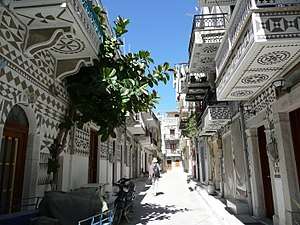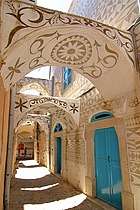Pyrgi, Greece
Pyrgi (Greek: Πυργί, Greek pronunciation: [pirˈʝi]) is a village on the Greek island of Chios, known as the "painted village" on account of the decoration of the houses. This mostly consists of black and white decorative motifs in different shapes.[2] Pyrgi is one of the biggest villages in Chios, located in the south part of the island, 25 km south of the island's capital. It is the traditional seat of the Mastic Villages, a group of villages where the residents engage with mastic agriculture. These villages have been added in representative List of the Intangible Cultural Heritage of Humanity of UNESCO.[3][4] The population of Pyrgi is 755 inhabitants according to the 2011 census.
Pyrgi Πυργί | |
|---|---|
 Street of Pyrgì | |
 Pyrgi | |
| Coordinates: 38°13′N 25°59′E | |
| Country | Greece |
| Administrative region | North Aegean |
| Regional unit | Chios |
| Municipality | Chios |
| Municipal unit | Mastichochoria |
| Elevation | 110 m (360 ft) |
| Population (2011)[1] | |
| • Rural | 755 |
| Community | |
| • Population | 832 (2011) |
| Time zone | UTC+2 (EET) |
| • Summer (DST) | UTC+3 (EEST) |
| Postal code | 821 00 |
| Area code(s) | 22710 |
| Vehicle registration | ΧΙ |
Description
Pyrgi still keeps the medieval style. The settlement's roads are narrow and are covered with arches or vaults. In the middle of the village there is a tower with a height of 18 meters. Around it, there are walls with four towers in the corners. In the village, there are three old churches, Agioi Apostoloi (the older church, built probably during 15th century),[5] Koimisis Theotokou and Taxiarchis. The village stands out from the other mastic villages because its houses are painted with decorative motifs in different shapes. The decorative motifs in the facade of the houses are called "Xistà".[6]
History
Pyrgi is possibly a medieval settlement, built before 10th century. It gathered population from different villages, whose residents settled in Pyrgi to avoid the pirates' raids. It is mentioned in documents of the 11th, 14th and 15th centuries. The village didn't suffer damage from the earthquake of 1881 and so it keeps the medieval style. Pyrgi became the seat of the Mastic community and nowadays it is the seat of the Mastichochoria municipal unit.
Historical population
| Census | Settlement | Community |
|---|---|---|
| 1991 | 1,164 | |
| 2001 | 1,044 | 1,314 |
| 2011 | 755 | 832 |
Gallery
 Street of the village
Street of the village House covered in sgraffito (local name:Xistà)
House covered in sgraffito (local name:Xistà) Other buildings
Other buildings Holy Apostles church
Holy Apostles church Theotokos church
Theotokos church Street of Pyrgi
Street of Pyrgi
References
- "Απογραφή Πληθυσμού - Κατοικιών 2011. ΜΟΝΙΜΟΣ Πληθυσμός" (in Greek). Hellenic Statistical Authority.
- "Πυργί". chios.gr. Retrieved 17 March 2016.
- "Know-how of cultivating mastic on the island of Chios". unesco.org. Retrieved 17 February 2016.
- "UNESCO recognizes the mastic cultivation of Chios". protothema.gr. Retrieved 17 February 2016.
- "Church of Agioi Apostoli at Pyrgi". odysseus.culture.gr. Retrieved 17 March 2016.
- "Pyrgi". gtp.gr. Retrieved 17 March 2016.